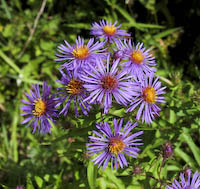 |
|
 |
 |
New England Aster
Symphyotrichum novae-angliae
(formerly Aster novae-angliae) |
 Other scientific names:
Aster novae-angliae, Aster roseus, Lasallea novae-angliae, Virgulus novae-angliae Other scientific names:
Aster novae-angliae, Aster roseus, Lasallea novae-angliae, Virgulus novae-angliae

French names:
Aster de la Nouvelle-Angleterre

Family:
Composite Family (Asteraceae)

Group:
Asters

Distinctive features:
Large rose-purple flowers, with very numerous rays. Clasping leaves. Rough stem. Leaves smell a bit spicy when crushed.

Similar species:
•
Purple-stemmed Aster (Symphyotrichum puniceum) - grows in wet areas, flowers have fewer rays. Leaves do not smell spicy when crushed.
•
Amethyst Aster (Symphyotrichum x amethystinum) - a hybrid between New England Aster & Heath Aster - much like a miniature New England Aster with more leaves and smaller leaves.

Flowers:
Summer, Autumn; White, Blue/Violet; 7 or more parts (petals); 3cm in diameter. Ray flowers: very numerous, 50-75, dark rose-purple to pink, sometimes white. Disc flowers: 50-100, yellow becoming purple.

Leaves:
Clasping stem. Crowded along the stem. Have three prominent veins. Lower leaves have usually disappeared by flowering time. Leaves are toothless. Smell a little bit spicy when crushed.

Height:
60-150 cm (23-59 in)

Stem:
Bristly-hairy. Stout.

Habitat:
Fields and Open Areas; Open areas, fields, roadsides.

Grows in Sun/Shade:
Sun

Books:
Newcomb's Wildflower Guide: 460
Peterson's Field Guide to Wildflowers: 308, 356
ROM Field Guide to Wildflowers of Ontario: 191

Native/Non-native:
Native

Status:
Common.

Notes:
This is the very common Aster that many people are familiar with. The very many ray flowers are distinctive. It is often sold in nurseries as a garden plant.

For more information visit:
Ontario Wildflowers

Photographs:
204 photographs available, of which 18 are featured on this page. SCROLL DOWN FOR PHOTOGRAPHS.

 |
 |
|
|
|
|
|
|
|  |
|